Description 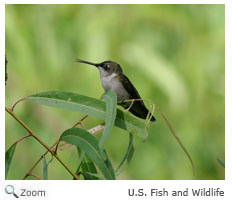 The ruby-throated hummingbird is the only species of hummingbird that breeds in eastern North America. It is 3-4
inches in length with a wingspan of
3-4
inches. The ruby-throated hummingbird beats is wings over 50 times every second.
It weighs only
3-4 grams, about the weight of a penny! It has a long, straight, thin, pointed bill. The male has an iridescent green
back, a ruby-red throat, a black chin, a light brown chest and belly, and a forked dark purple to black tail. The female has an iridescent green
back; a grayish-white throat, chest, and belly; and white tips on her tail feathers. The ruby-throated hummingbird is the only species of hummingbird that breeds in eastern North America. It is 3-4
inches in length with a wingspan of
3-4
inches. The ruby-throated hummingbird beats is wings over 50 times every second.
It weighs only
3-4 grams, about the weight of a penny! It has a long, straight, thin, pointed bill. The male has an iridescent green
back, a ruby-red throat, a black chin, a light brown chest and belly, and a forked dark purple to black tail. The female has an iridescent green
back; a grayish-white throat, chest, and belly; and white tips on her tail feathers.
Range 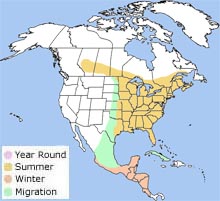 The ruby-throated hummingbird
breeds east of the Mississippi River in the United States from southern Canada to the Gulf Coast. It winters
in southern Mexico and Central America south to Costa Rica. The ruby-throated hummingbird
breeds east of the Mississippi River in the United States from southern Canada to the Gulf Coast. It winters
in southern Mexico and Central America south to Costa Rica.
Habitat
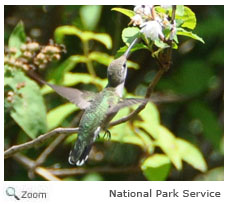 The ruby-throated hummingbird is found in
in mixed woodlands and eastern deciduous forests, gardens, parks, and orchards during the breeding season. In the winter, it is found in
tropical forests, forest edges, scrubland, old fields, and citrus groves. The ruby-throated hummingbird is found in
in mixed woodlands and eastern deciduous forests, gardens, parks, and orchards during the breeding season. In the winter, it is found in
tropical forests, forest edges, scrubland, old fields, and citrus groves.
|
|
Diet
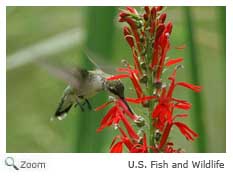 The ruby-throated hummingbird hovers over a flower and uses its long tongue to collect nectar. It also eats insects. It is especially attracted to red tube-shaped flowers and often eats the nectar of salvia, trumpet creeper, bee balm, thistle, petunia, coral honeysuckle, wild bergamot, cardinal flower, buckeye, jewelweed, and columbine. It can eat its own weight in nectar each day! The ruby-throated hummingbird hovers over a flower and uses its long tongue to collect nectar. It also eats insects. It is especially attracted to red tube-shaped flowers and often eats the nectar of salvia, trumpet creeper, bee balm, thistle, petunia, coral honeysuckle, wild bergamot, cardinal flower, buckeye, jewelweed, and columbine. It can eat its own weight in nectar each day!
Life Cycle
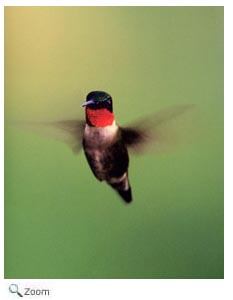 The male ruby-throated hummingbird courts the female by flying in loops and diving over the female and then flying in
side-to-side horizontal arcs. If the female is interested, she calls out to the male and tips her head to the side. The male will mate with more than one female. The female makes a
cup-shaped nest on a tree branch. The nest is made of plant matter like thistles and dandelion down and is held together with spider webs and covered in lichen. The female lays 1-3 eggs and incubates them for 10-14 days. The chicks fledge when they are 18-22 days old, but the female may continue to feed them for another 4-7 days. The female may have as any as three broods a year. The male ruby-throated hummingbird courts the female by flying in loops and diving over the female and then flying in
side-to-side horizontal arcs. If the female is interested, she calls out to the male and tips her head to the side. The male will mate with more than one female. The female makes a
cup-shaped nest on a tree branch. The nest is made of plant matter like thistles and dandelion down and is held together with spider webs and covered in lichen. The female lays 1-3 eggs and incubates them for 10-14 days. The chicks fledge when they are 18-22 days old, but the female may continue to feed them for another 4-7 days. The female may have as any as three broods a year.
Behavior
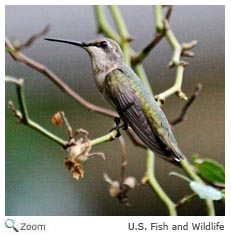 The ruby-throated hummingbird is a solitary bird, except during breeding season and when raising young. It has very tiny feet and never walks on the ground. It may perch for brief periods of time on a twig or wire or on its nest. When the weather is cold the ruby-throated hummingbird drops its body temperature and heart rate and goes into torpor to save energy. It can take 30 minutes or so for a hummingbird to come out of torpor. The ruby-throated hummingbird is a solitary bird, except during breeding season and when raising young. It has very tiny feet and never walks on the ground. It may perch for brief periods of time on a twig or wire or on its nest. When the weather is cold the ruby-throated hummingbird drops its body temperature and heart rate and goes into torpor to save energy. It can take 30 minutes or so for a hummingbird to come out of torpor.
|